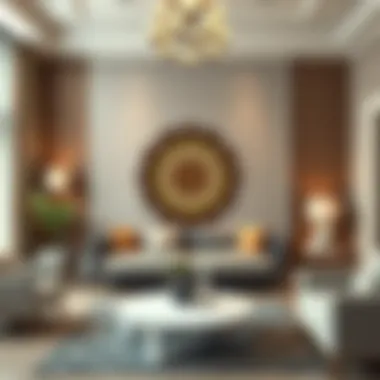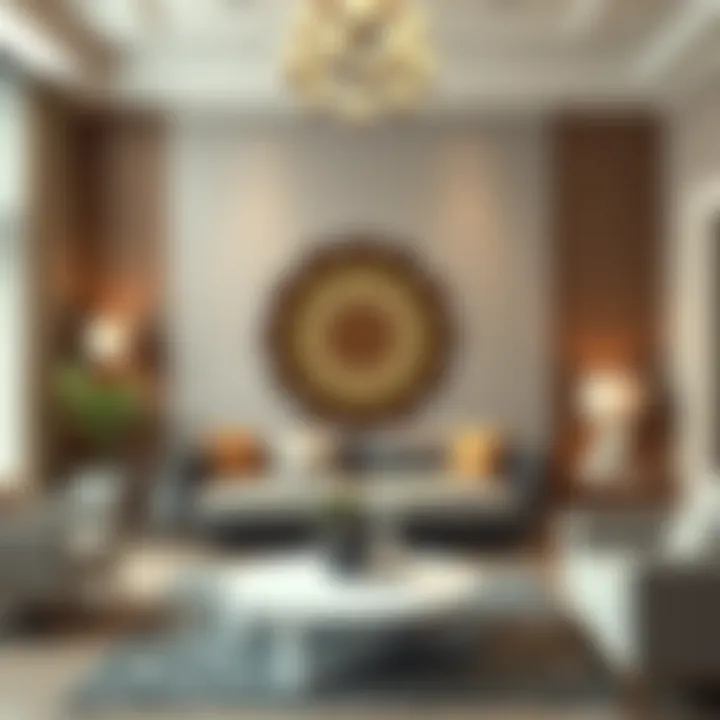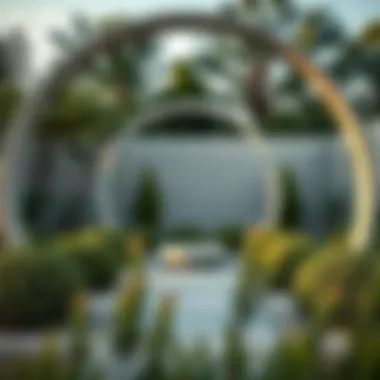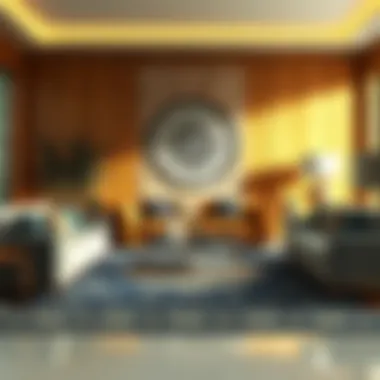Sacred Geometry's Impact on Home Decor


Intro
In a world where aesthetic appeal meets deeper symbolism, sacred geometry stands out as a key component in the realm of home decor. This intricate system of shapes and patterns transcends mere visual beauty, infusing spaces with harmony and meaning. From the golden ratio to the Fibonacci sequence, these geometric constructs manifest not just in art but within our living spaces, shaping our perceptions and sensations.
Understanding the impact of sacred geometry goes beyond finding a symmetrical pattern or a pleasing arrangement; it's about tapping into historical significance and psychological resonance. For thousands of years, cultures around the globe have utilized these designs to create spaces that evoke a sense of balance and tranquility. Whether it's the measure of a room or the choice of decor, sacred geometry can play a crucial role in defining the ambiance of a home.
This article endeavors to illuminate the various aspects associated with the application of sacred geometry in home decor. We will explore the patterns that speak to the subconscious, the influence these shapes have on our mood and mindset, and the practical strategies for integrating these elements into contemporary design. A comprehensive understanding of these concepts can help transform living spaces from mere shelters into realms of peace and aesthetic delight.
By embracing the principles of sacred geometry, interior designers, home decorators, and anyone aiming to create a harmonious environment can enhance their work. This guide helps you navigate through the principles of this ancient art form, fostering a deeper connection to your living environment. Dive in, as we unpack these historical layers and offer insights on how to mindfully incorporate sacred geometric patterns into your home.
Understanding Sacred Geometry
Sacred geometry serves as the foundation of many artistic and architectural expressions throughout history and into present day. Recognizing the significance of this field lays the groundwork for appreciating how geometric patterns shape the aesthetics and ambiance of our living spaces. In the world of home decor, integrating sacred geometric designs can elevate not just the visual appeal, but also create a sense of harmony and balance in a space.
When discussing sacred geometry, it's about finding meaning in forms and how they resonate on various levels within the human experience. Whether through mindfulness of the designs chosen or the emotional responses they evoke, understanding these patterns intricately connects with both the physicality of a space and the psychology of its inhabitants.
A house isn't merely bricks and mortar; it’s an extension of ourselves, and using sacred geometry can profoundly impact the feeling of being at home.
Definition and Origins
Sacred geometry refers to the set of geometric shapes and patterns that are believed to hold spiritual significance. The term encompasses ancient forms such as circles, triangles, and squares, which have been used since antiquity in various cultures to represent cosmic harmony and the interconnectedness of life. The origins of this concept can be traced back to civilizations like the Egyptians, Greeks, and various Indigenous cultures who infused their beliefs and philosophies into their architecture and designs. From the pyramids of Giza to the intricate designs in Hindu temples, these patterns reflect an understanding of nature and existence that transcends mere aesthetics.
Cultural Significance
Across cultures, sacred geometry has played a crucial role. The patterns are often seen in religious architecture, artworks, and rituals. For instance, in Christianity, the Star of Bethlehem holds geometrical importance, while in Islam, intricate tile work echoes principles of symmetry and order derived from geometric shapes. This visibility of geometric principles in sacred spaces signifies a deeper connection between art, spirituality, and the natural world.
In the modern context, recognizing this history enables us to appreciate the ways in which these shapes can bring a sense of spiritual resonance into our own homes. Incorporating them into decor can transform an ordinary space into something more meaningful and reflective of a greater design philosophy.
Basic Geometric Shapes
Circle
The circle is one of the most powerful symbols in sacred geometry. It represents unity, wholeness, and the cyclical nature of life. When it comes to home decor, incorporating circular elements can create focal points that draw the eye and instill a sense of completeness. Furthermore, the absence of corners in circles contributes to a feeling of comfort, as it's often associated with nurturing and safety. For decorators, using circular motifs—such as mirrors, rugs, or wall art—can enhance visuals and engender a cozy atmosphere within any room.
Triangle
The triangle is a symbol of stability and strength. Its three sides can represent various triads, like mind, body, and spirit, or birth, life, and death. In home design, triangles can be utilized in various forms—from artwork to furniture arrangements—to convey balance. They provide direction and guide viewers’ eyes through spaces, making them a popular choice among decorators who wish to create a dynamic yet balanced environment. However, triangles' sharp angles might evoke tension if overused, so it’s important to balance these with softer shapes for an inviting feel.
Square
Often representing order and reliability, the square provides grounding energy to a space. Whether through furniture layouts or tile patterns, squares create a sense of stability that is comforting in any home. Their rigid form can be particularly beneficial in communal areas where social interactions occur. However, over-reliance on square forms might lead to a monotonous feel, so blending with circular or triangular shapes can enhance variety and movement within a design.
By dissecting these basic geometric shapes, one can better appreciate their roles in not only artistic expression but also their emotional and psychological impacts on the design of living spaces.
Psychological Impact of Geometric Shapes
In the realm of design, the impact of geometric shapes stretches far beyond mere aesthetics. Sacred geometry plays a key role in creating environments that resonate at deeper levels, affecting not only the style but also the feelings and interactions within a space. Understanding how these shapes inform our psychological responses can be incredibly beneficial for designers, stylists, and marketers alike. By taking notice of the subtle influences geometric patterns exert, one can craft spaces that evoke serenity, focus, or even creativity.
Visual Harmony
Visual harmony is often described as a pleasing arrangement that catches the eye. In sacred geometry, shapes like circles and triangles are known for their inherent balance. Utilizing these shapes within a space can guide a person's eye smoothly across the room, making the environment feel cohesive. For example, a living room adorned with circular motifs may encourage relaxation and ease because circles, considered infinite and perfect, can evoke a sense of completeness.
Interestingly, a study published on the impact of visual elements in spaces revealed that environments with geometrically harmonious designs lead to improved mood and reduced anxiety. When used effectively, geometric patterns can create a rhythm in design that binds different elements together—so that each aspect complements rather than competes.
"Visual harmony can transform any area into a sanctuary of peace, bringing equilibrium to the senses."
Emotional Resonance


Shapes convey emotions. The triangle, for instance, can imply strength and stability, often found in architectural designs that are imposing yet confident. On the other hand, curves often suggest softness and gentleness. Incorporating these shapes strategically allows decorators to establish an emotional temperature within a space.
Furthermore, research indicates that our emotional responses are often tied to the geometry present. A space that feels disorganized may lead to feelings of anxiety or unease. In contrast, spaces that incorporate fluid, organic shapes often evoked feelings of comfort and security. When designers consciously consider the emotional weight each shape carries, they can curate experiences that are not only visually striking but also emotionally fulfilling.
Cognitive Responses
The cognitive impact of geometry is equally compelling. Our brains are wired to recognize patterns, and thus, geometric shapes can influence our thought processes. Specifically, well-structured designs can enhance focus and cognition. For example, an office designed with geometric minimalism can lead to increased productivity, creating an environment that fosters clear thinking and efficiency.
Furthermore, the use of familiar geometric forms can speed up our understanding of space. Spaces that are designed thoughtfully with sacred geometry allow for intuitive navigation, making it easier for occupants to feel at home. Insights from behavioral studies highlight that when individuals engage with spaces incorporating familiar geometric shapes, they report feeling more comfortable and less mentally taxed. This interplay of design and cognitive science underscores why thoughtful integration of sacred geometry in home decor is so crucial.
Incorporating Sacred Geometry in Home Decor
Incorporating sacred geometry into home decor is like weaving a story into the fabric of your living space. It's not just an eye-catching trend; it is an exploration of meaning through shapes that have stood the test of time. The act of integrating these patterns reflects a desire to create an environment that resonates with harmony and balance. When spaces are designed with specific geometric principles in mind, they can foster tranquility and improve the overall ambiance of a home.
Decorative Elements
Textiles
Textiles that feature sacred geometry can bring a unique depth to your decor. Think of a tapestry adorned with intricate mandalas or pillows showcasing Fibonacci spirals. These textile choices are significant not just for aesthetics but also for their ability to evoke a sense of calm. The key characteristic of textiles is their versatility; they can easily transform a dull space into a vibrant one.
A standout feature of textiles is their tactile quality, inviting touch while adding layers of warmth. They can also absorb light and sound, contributing to a cozy atmosphere. However, finding textiles that align with your vision may take some effort. Sometimes, they might clash with other patterns in your home. So, choosing wisely is crucial.
Wall Art
When it comes to wall art, incorporating sacred geometry can serve as a powerful focal point. Imagine a wall graced with a large geometric mural that draws the eye and sparks conversation. It stands out due to its ability to blend tradition with contemporary design.
The unique feature of wall art in sacred geometry lies in its ability to transform an entire room's energy. Such pieces can be meditative, inviting viewers to pause and reflect. However, one must consider the art’s placement carefully; if it's too busy or overwhelming, it may create visual chaos instead of harmony.
Flooring
Flooring imbued with sacred geometric designs can act as the very foundation of your home’s aesthetic. Patterns on tiles or wood that follow geometric principles add a sophisticated touch beneath your feet. The main characteristic of geometric flooring is its longevity and statement-making ability.
A unique benefit of geometric flooring is its potential for guiding movement in a space, subtly directing foot traffic in a way that flows naturally. On the flip side, bold patterns might not suit everyone’s taste and can become less appealing over time. Thus, striking the right balance when selecting such flooring is paramount.
Furniture Design
Geometric Patterns in Upholstery
Upholstery that showcases geometric patterns can redefine furniture’s role in a room. Whether it’s a sofa dressed in a tessellated fabric or accent chairs featuring angular designs, these details create a modern vibe. The appealing aspect of geometric patterns is their ability to mix and match seamlessly with other styles.
One distinctive benefit of such patterns is they help to mask wear and tear better than solid fabrics. However, they can overwhelm a small space, making it feel busy. So, opting for a few key pieces rather than all-out coverage may be best.
Sculptural Form
Sculptural forms in furniture not only function as seating or storage but become art pieces in themselves. Think of a coffee table shaped like a dodecahedron or a chair with interlocking curves. This design choice elevates ordinary items, transforming them into conversation starters.
The main trait that makes sculptural furniture worthwhile is its unexpected presence in a room. Such forms often invite curiosity and contemplation. That said, sculptural pieces may occupy more visual space and feel out of place in minimalist settings. Thus, careful consideration of the overall decor is crucial.
Multi-functional Pieces
Multi-functional pieces designed with sacred geometry can maximize space and utility without sacrificing style. Classical furniture forms reinterpreted with geometric designs, like a foldable desk or an ottoman that doubles as storage, serve practical purposes while enhancing decor. The key characteristic here is their adaptability to different needs and situations.
A distinct advantage is that they often encourage less clutter by serving multiple purposes. However, functionality without a clear design can lead to chaos rather than harmony. Therefore, checking the aesthetic cohesion with other decor is necessary as you choose.
Lighting Solutions
Chandeliers and Fixtures
Chandeliers designed with sacred geometry provide more than just illumination; they become a centerpiece in the room. A light fixture shaped like a sacred geometric symbol or inspired by a fractal design can draw admiring glances. Such fixtures significantly embody elegance.
What makes them stand out is the way they distribute light, creating patterns of shadows and brilliance. Yet, depending on their size and style, they can overpower less spacious rooms, so patience in selection is key.
Natural Light Enhancements
Employing sacred geometry in approaches to natural light, like window designs or skylights, introduces an airy feel to any space. Picture a room where sun rays filter through a latticed geometric window; the result can be stunning and uplifting. The characteristic trait here is the seamless integration with natural elements.
Additionally, this design can augment energy efficiency, as leveraging daylight reduces the need for artificial lighting. However, too many contrasts within existing decor can clash with the serene influence of such enhancements. A balanced approach ensures harmony prevails.
Color Theory and Sacred Geometry
Color plays a crucial role in the realm of sacred geometry, as it intertwines with the aesthetic experience and psychological impact of the geometric shapes that populate our living spaces. Understanding the connection between color theory and sacred geometry empowers designers, stylists, and homeowners to thoughtfully select colors that enhance the energy and ambiance of a room. When applied judiciously, the right color choices, alongside geometric patterns, can evoke emotional responses, create harmony, and redefine spatial perceptions within a home.
Harmonizing Colors


Harmonizing colors is vital for achieving a balanced and inviting space. In the context of sacred geometry, certain color combinations can either complement or clash with geometric patterns, influencing the overall mood.
- Analogous Colors: These colors sit next to each other on the color wheel, creating a serene visual experience. For instance, a palette of blues and greens can beautifully offset circular motifs, enhancing the flow of energy within the room.
- Complementary Colors: On the flip side, complementary colors, which sit opposite each other, can create dynamic contrast. This is especially useful when highlighting focal points, such as a triangular piece that demands attention against warmer tones.
The use of color harmonization is akin to tuning an instrument; when done right, it strikes a chord that resonates with anyone who enters the space.
Symbolism of Colors
Colors carry distinct meanings and symbolism, which can greatly affect how a design is perceived. In sacred geometry, certain colors are often associated with specific energies and emotional states.
- Blue: Symbolizes tranquility and depth. It's reminiscent of the sky and ocean, conducive to feelings of peace, especially when incorporated in circular designs, representing continuity.
- Red: Conveys passion and energy. In geometric decor, it can inject vitality into spaces, particularly in angles or sharp shapes that denote movement or action.
- Green: Associated with nature and growth. This color can symbolize renewal and balance, working harmoniously in spaces designed with rectangular patterns that promote stability.
Think of colors like layers of narrative, each contributing a chapter to the overall story told by space.
Creating Ambiance through Color
Color is more than just visual appeal; it orchestrates the ambiance within a home. Through sacred geometry, designers can harness colors to mold the atmosphere of a room.
- Warm Colors: Shades like yellows, oranges, and reds can create an energetic and inviting feel. These tones are excellent choices in areas intended for socializing, such as living rooms or dining areas adorned with geometric wall art that radiates warmth.
- Cool Colors: Blues and greens can cultivate a calm and relaxing environment, perfect for bedrooms or meditation spaces featuring soft, flowing shapes. The gentle curves of a circular design can enhance the soothing effect of these colors.
- Neutral Colors: Grays, whites, and browns act as a backdrop that allows vibrant colors to stand out. For instance, a neutral-toned room can serve as a serene canvas for intricate geometric patterns that pop with color.
Utilizing color effectively can lead to profoundly impactful interiors, guiding emotions and setting the desired mood for each space.
"The right colors can create a powerful synergy with sacred geometric forms, altering not just how a room looks, but how it feels."
By grasping the interplay of color theory and sacred geometry, one can elevate the aesthetic and emotional quality of any environment, enriching the lives of those who inhabit it.
Examples of Sacred Geometry in Design
Sacred geometry serves as a rich canvas for expressing creativity and a bridge to the natural world. Understanding how these patterns are woven into various styles is essential not just for aesthetic appeal, but also for the emotional atmospheres they create. The integration of sacred geometry can uplift spaces, infusing them with a sense of tranquility and harmony. Moreover, recognizing how different environments utilize these designs offers insights into their timeless influence across cultures and epochs.
Contemporary Interiors
In modern design, sacred geometry often finds its way into interiors as a subtle yet profound element. A quintessential example can be seen in the use of the Fibonacci sequence, which resonates in various aspects of furniture arrangement and spatial planning. For instance, a living area may feature a chair geometrically placed to maintain a balanced focal point within the room. This creates not just a pleasing visual but also enhances movement and flow.
Moreover, geometric-patterned wallpaper or textiles can imbue a contemporary home with an artistic flair. The repetition of shapes, like hexagons or rounded forms echoing circles, can evoke feelings of rhythm and unity. These choices often reflect a homeowner's personality and can steer guests’ perceptions as well. It's critical, however, to strike a balance. Overstuffing a space with geometric motifs can lead to visual chaos, so wisely selected accents can accentuate without overwhelming.
Traditional Spaces
When it comes to traditional design, sacred geometry offers heritage and an abiding sense of history. Spaces such as Mediterranean homes or Victorian-style interiors often utilize these patterns in intricate moldings or tile work. Take for instance the classic tessellation found in Islamic architecture, which carries profound mathematical importance while serving as breathtaking decor.
In a traditional dining room, the inclusion of a circular motif in the table design can foster community and closeness, resonating with ages of gathered families. Rugs featuring symmetrical patterns can define spaces, guiding the eye while remaining rooted in tradition. However, maintaining the connection to cultural significance without modern alterations is crucial. Often, this means collaborating with artisans who understand the deeper meanings behind these designs.
Commercial Applications
Business spaces are beginning to embrace sacred geometry not just for aesthetic gratification, but to enhance customer experience and productivity. Retail environments, for example, cleverly apply geometric layouts in merchandising. A well-organized geometric display can direct foot traffic, spotlight key products, and elevate the overall shopping experience.
In the realm of hospitality, hotels and restaurants increasingly use these designs to evoke specific moods. A property designed with archways in harmonious proportions might instill an air of calmness, encouraging patrons to linger longer. Beyond just the look, such designs have psychological weight that can impact clientele’s behaviors and sense of belonging in the space.
Ultimately, sacred geometry in commercial spaces marries function with form. Designing with these principles not only beautifies an environment but can also translate into tangible benefits, such as increased dwell times and sales boosts.
"Sacred geometry is not merely a visual art; it serves as a language that speaks of balance and harmony within space."\n Utilizing sacred geometry in design helps forge connections not only with the spaces we inhabit but also with the deeper meanings embedded in those spaces. By diving deep into contemporary, traditional, and commercial designs, we elucidate the vital role these patterns play in our everyday lives.
Challenges and Considerations
Incorporating sacred geometry in home decor comes with its own set of challenges and considerations. Navigating these complexities can affect not just the aesthetic appeal of a space, but also how it feels and functions. Therefore, understanding these challenges is crucial for those who want to use sacred geometry to enhance their living environments. Below, we’ll explore three pertinent aspects that merit careful thought when using geometric designs.
Overuse of Patterns


When it comes to sacred geometry, patterns can be a double-edged sword. On one hand, they bring vibrancy and depth to a room; on the other, overusing them can lead to a chaotic visual experience.
- Cluttered Atmosphere: Too many geometric shapes can overwhelm the senses, creating a cluttered and disjointed atmosphere. Spaces should aspire for harmony, allowing each element to breathe.
- Distraction: Patterns that are too bold or busy can draw attention away from the intended focal points of a room. This can interfere with the overall flow and mood you might be hoping to achieve.
To avoid overuse, consider limiting geometric patterns to one or two focal areas in a room, like a statement wall or key furniture pieces. This creates a balanced visual interest without overwhelming the eye.
"Less is often more; a few skillfully placed elements often tell a more powerful story than many competing ones."
Balancing Simplicity and Complexity
Striking a balance between simplicity and complexity is another critical consideration in sacred geometry. While intricate designs can be mesmerizing, simplicity speaks volumes too. It all comes down to your personal taste and the message you want your space to convey.
- Complexity can evoke curiosity but may also feel heavy or oppressive if not carefully applied. Too much intricacy might lead to a space that feels like a maze rather than a home.
- Simplicity, on the other hand, can offer clarity and calm, making it a favorable choice for spaces meant for relaxation and peace.
For a successful balance, consider using bold, complex patterns as accents, while keeping larger areas—like walls and floors—more muted. This approach fosters a sophisticated interplay that can elevate a space.
Personal Taste and Aesthetics
Ultimately, personal taste plays a significant role in the successful incorporation of sacred geometry into any home decor. Everyone has a different aesthetic sensibility, influenced by culture, upbringing, and experiences.
- Reflect Your Style: What resonates with you? A geometric pattern can evoke emotions; choose shapes that define your identity. You might want a more minimalist approach or perhaps a design that's rich with history and meaning.
- Seek Consistency: Your decor choices should collectively tell a story, harmonizing various elements in your space. Strive for synergy between geometric designs and other decor styles, colors, and textures.
Sustainability in Sacred Geometry Decor
As the world increasingly prioritizes sustainability, its intersection with design becomes ever more poignant. Sacred geometry decor not only embodies aesthetic appeal but also promotes principles of environmental consciousness. By integrating sustainable practices, one can ensure that the beauty of geometric harmony remains unblemished by ecological concerns. This section will delve into the vital elements of sustainability in sacred geometry, including the significance of eco-friendly materials and the timelessness of designs that reduce waste.
Eco-Friendly Materials
A cornerstone of sustainable decor, eco-friendly materials contribute not just to a healthier planet but also to a feeling of natural serenity that complements the calming effects of sacred geometry. Naturally sourced elements such as bamboo, hemp, and recycled metals can reinvigorate spaces while minimizing the design’s ecological footprint. The use of plant-based paints and finishes further enhances the environmental benefits, while providing a spectrum of colors that resonate with various forms of geometry.
Here are some key points about eco-friendly materials:
- Bamboo: Fast-growing and sustainable, this material can be crafted into various geometric shapes while adding a warm, organic touch to a room.
- Reclaimed Wood: Using wood from old structures not only tells a story but also gives unique character to decor items, while reducing waste and deforestation.
- Recycled Glass: Perfect for lighting fixtures or table decorations, recycled glass can sparkle like new without the environmental toll of new production.
Choosing these materials elevates sacred geometry from mere decoration to a philosophy of living responsibly, ensuring that every piece resonates with a purpose beyond aesthetics.
Timeless Designs
While trends in home decor come and go, sacred geometry has stood the test of time, revealing its enduring nature. The designs that utilize geometric forms often transcend fleeting fashions, appealing to a sense of permanence that can anchor a space’s aesthetic. The classic circle, triangle, and square can be interwoven into designs that feel both modern and historic, lending themselves to functionality and style.
Timeless designs can also foster sustainability in several ways:
- Durability: Well-made pieces that harness sacred geometry principles often boast longevity, reducing the need for replacements and thereby minimizing waste.
- Versatility: Timeless geometric shapes can adapt to various styles and functions. A single piece might complement a minimalist setting today and fit into a bohemian vibe tomorrow.
Incorporating timeless designs into decor not only ensures an unwavering aesthetic appeal but also fosters a deeper connection to the aforementioned sustainability principles. This allows the home to evolve without losing its foundational beauty.
"When design meets sustainability, it creates a ripple effect, encouraging more conscious choices in every aspect of life."
By prioritizing sustainability through eco-friendly materials and timeless designs, sacred geometry’s role in home decor becomes a multidimensional experience, reflecting personal values and artistic expression. This symbiotic relationship highlights the capacity for design to be both beautiful and responsible, serving the caretakers of the planet undeniably.
Closure
The conclusion of the article brings to light the intricate relationship between sacred geometry and home decor, serving as a significant reminder of how deliberate choices can reset the atmosphere of personal spaces. By understanding the nuances of geometric designs, one can appreciate not merely their aesthetic quality but also their potential to foster well-being and harmony within a home.
Recap of Key Points
- Historical Background: Sacred geometry isn't just a trend; it's rooted in history and culture, symbolizing profound meanings across various societies. This deep connection underlines the importance of being mindful of such histories while incorporating designs.
- Psychological Influence: Patterns in geometry can evoke certain emotions and reactions, shaping the way one feels in a particular space. The balance between shapes and colors can play a pivotal role in creating either a calming haven or an energizing environment.
- Practical Incorporation: From textiles and wall art to furniture design and lighting solutions, there are multiple avenues to weave geometric concepts into home decor. Understanding practical applications allows for a more personalized and intentional approach.
- Sustainability Considerations: Your choices matter not only aesthetically but also environmentally. Opting for eco-friendly materials and timeless designs reflects a commitment to sustainability within the realm of sacred geometry decor.
Final Thoughts on Sacred Geometry
Sacred geometry is more than just a decorative style; it is a philosophy that can significantly enhance the living spaces we create. As a home decorator or designer, embracing these elements invites not only beauty into a space but also a deeper connection to the resonance that these shapes and patterns carry.
In today’s consumer-driven world, the principles of sacred geometry challenge us to consider what we welcome into our environments. How do we balance beauty with purpose? The merging of both can lead to a transformative experience within one’s home. By adopting these practices, individuals can foster spaces that reflect inner peace, personal values, and a keen awareness of the delicate balance between form, function, and feeling.















